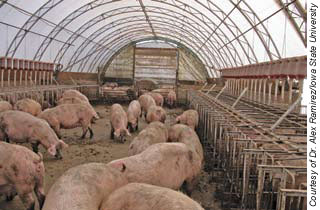Speakers discuss ways to make group sow housing work
 Swine veterinarians and animal scientists continue to examine group housing for pregnant sows in response to public criticism of gestation stalls.
Swine veterinarians and animal scientists continue to examine group housing for pregnant sows in response to public criticism of gestation stalls.
"Housing and Managing the Modern Sow in Gestation" was the subject of a session at the recent annual meeting of the American Association of Swine Veterinarians. Speakers didn't defend the benefits of gestation stalls so much as they described various approaches to group housing.
Edmond A. Pajor, PhD, of the Purdue University Department of Animal Sciences said gestation stalls and group housing each present welfare challenges. Stalls pose issues of space and social deprivation, and groups pose issues of aggression. Sow aggression is natural to establish group hierarchy, Dr. Pajor said, but it is also rare in nature because more extensive environments allow for avoidance.
Dr. Pajor said management practices to reduce aggression in group housing include forming static groups of sows early in gestation and creating subgroups of sows for introduction into dynamic groups. Pen design can decrease aggression with options such as partitions and individual feeding stalls. He said genetic selection against aggression would be helpful as well.
Kenneth Stalder, PhD, of the Iowa State University Department of Animal Science spoke about sow longevity and mortality in general and in regard to housing.
Dr. Stalder said foot and limb issues are common causes of mortality and reasons for culling, while reproductive failure is the most common reason for culling. Sows have a lot of profit potential if they can remain in the herd longer, however.
"I'd like you not to think of the sow as a perishable commodity," Dr. Stalder said.
For group housing, Dr. Stalder emphasized the importance of foot and limb soundness in sows and good stockmanship skills in workers.
Malachy Young, PhD, of Gowans Feed Consulting in Alberta related his experiences with electronic sow feeding systems in group housing. Each electronic feeder is a stall with automatically closing gates. When a sow enters the feeder, the system reads the sow's electronic identification tag to determine how much feed to dispense.
Dr. Young said electronic feeders allow producers to reduce sow aggression, minimize wastage, and feed more than one diet. A disadvantage is that the set-up and operation of such systems is more expensive.
Dr. Steve Henry of Abilene Animal Hospital in Kansas described farms that have converted old finishing barns into group sow housing. The farms then experimented with feeding the sows multiple times per day to decrease aggression without installing individual feeding stalls.
Dr. Henry said trial and error determined how many times per day to drop feed into troughs or onto floors—and how much feed to drop. More frequent feeding did lead to less aggression. Dr. Henry said farms also could convert stall barns into group housing.
"You got an old barn, go to work and try it," Dr. Henry said. "See what happens."